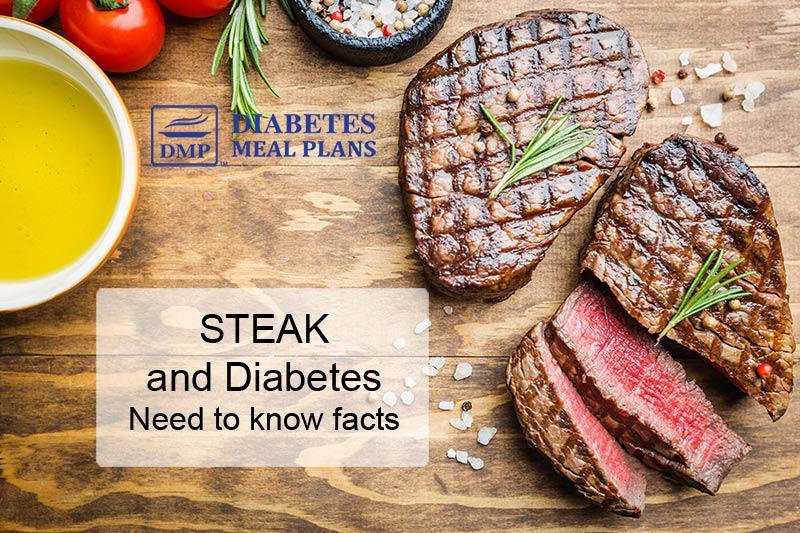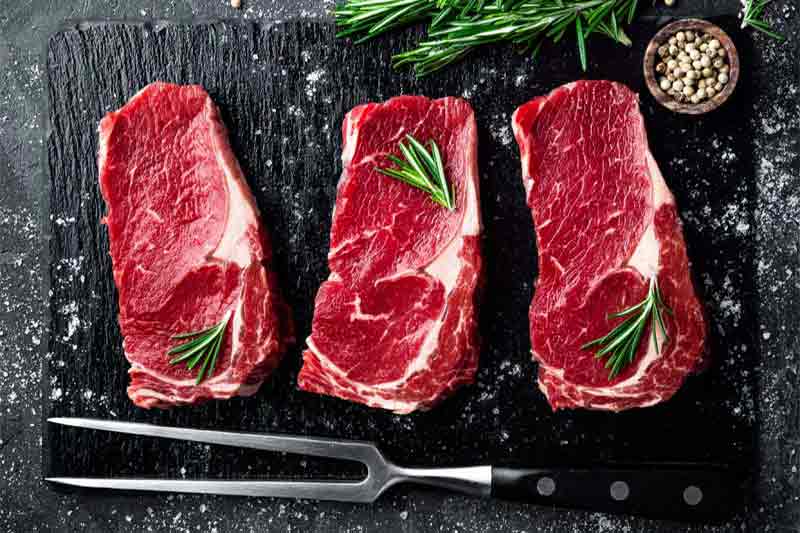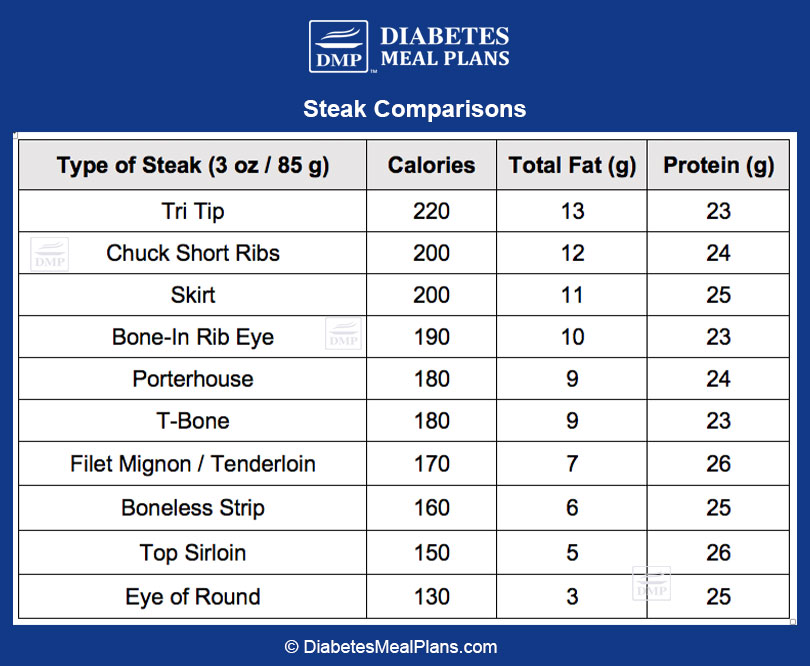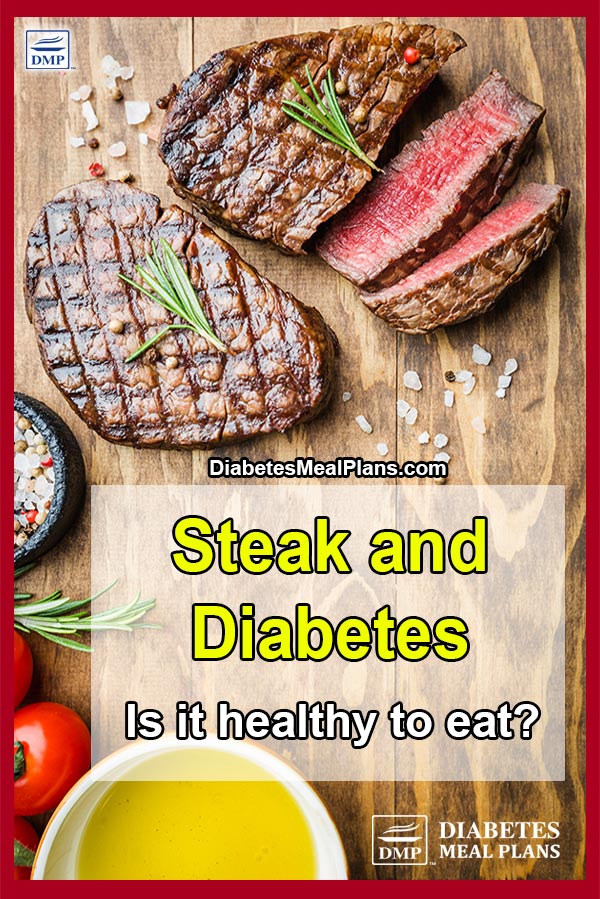Nothing beats the satisfying sizzle of a fresh steak on the grill.
A perfectly seasoned, crispy-yet-tender steak can make a dinner at home feel like 5-star dining experience!
But, can people with prediabetes or type 2 diabetes eat steak?
Something that tastes so good can’t be bad for you, right?
Let’s find out…

Red Meat and Diabetes: Is It Healthy?
Red meat comes from land mammals (beef, pork, lamb) while white meat comes from birds (turkey and chicken). Red meat is often called the “less healthy” option because it contains more fat (saturated fat, specifically) than its white meat counterparts.
While red meat does contain more fat, that’s hardly a bad thing!
Fat plays many vital roles in the body, like fueling energy metabolism and storage, organ health, hormone balance, and supporting many other body systems.
In addition, red meat tends to contain more iron, more B vitamins, and more protein than white meat.
Red meat is an especially useful tool in the context of a low carb diet, such as we recommend here at DMP for diabetes management. When carbs are greatly reduced in the diet, you have to make up the missing “energy” (calories) by increasing your intake of protein and fat.
Oh, and have we mentioned blood sugar stability yet?
The combination of fat and protein found in red meat works wonders on your blood sugar. While high carb foods can shoot your blood sugar into the stratosphere, foods high in fat and protein can provide stable blood sugar and insulin levels for hours.
When done correctly, a diet lower in carbs and higher in protein and fat (alongside plenty of high fiber veggies) can work wonders for blood sugar stability, heart health, and weight loss.
Steak Nutrition Facts
Let’s look at the nutrition facts for an average servings of steak (about 3 oz when cooked, 4 oz raw).
This standard serving is roughly the size of the palm of your hand or a deck of cards. You may opt for a larger portion, but you’ll have to scale up the numbers to match your serving size.
For example, if you indulge in a 6 oz steak, you’ll be consuming double the macronutrients listed below.
Nutrition facts for a 3 oz filet mignon/tenderloin steak (cooked):
- Calories: 170
- Protein: 26g
- Fat: 7g
- Carbs: 0g
- Fiber: 0g
Most cuts of steak will be high in protein and fat but low in carbs. The amount of fat will vary depending on the cut, but as we mentioned earlier, there’s no reason to fear this type of fat!
FUN FACT
A steak contains all types of fats and is high in monounsaturated fat, not just saturated fat as most people assume.

Nutrition Facts; 3.5oz/100g beef steak, with visible fat eaten
15.1g fat
- Monounsaturated fat 6.4g
- Saturated fat 6.0g
- Polyunsaturated fat 0.6g
Best Cuts of Steak
Just as beauty is in the eye of the beholder, determining the “best” cut of steak is difficult since it’s based on personal preference. Each cut is beautiful in it’s own way and everyone may have a different take on what makes a great cut of meat.
That being said, the most popular cuts tend to be Flank (a very tender and flavorful piece of meat along the abdomen), the well-marbled New York Strip, and the Prime Rib (a favorite for slow-cooker enthusiasts).
Other favorites are sirloin, tenderloin (filet mignon), porterhouse (a dual-cut delight made of New York strip and filet mignon), Rib-Eye, and the classic T-bone steak.
Each cut will have a slightly different fat-to-protein ratio and a different calorie count.
Steak Nutrition Comparison Chart
Let’s have a look at how a few popular cuts compare:

Keep in mind that these numbers are based on a typical 3 oz serving size, so if you’re going for a 6 oz steak (or larger) be sure to adjust accordingly.
You may notice that the steaks with the highest calories also have the highest amount of fat. This isn’t a coincidence!
Protein contains just 4 calories per gram while fat supplies 9 calories per gram.
This may sound like a strike against fat, but it’s actually not. Calories supply energy to the body, which means that a fattier cut of meat is actually a great source of energy to help you think clearly, repair well, and move your body throughout the day.
Yes, you can overboard with calories when eating red meat, but you’re more likely to eat excess calories in the form of inflammatory, high carb foods like sweets, soda, alcohol, rice, pasta, and bread.
A healthy low carb diet cuts the amount of grain and sugar in your diet, leaving room for plenty of protein and fat-rich foods like red meat without having to worry about weight gain.

Tips for Preparing Steak
When paired with a nice serving of fiber-rich veggies, steak makes an excellent main dish for dinner. You may find that different steaks work best for different meals:
- Best for Fajita Meat: skirt steak, flank steak, and round steak
- Best for Outdoor Grilling: T-bone, filet mignon/tenderloin, strip steak
- Best for Oven Roasting & Broiling: Tri-tip, sirloin top roast, rib eye
- Best for Smoking: Rib eye, filet mignon/tenderloin, New York strip
- Best for Pot Roast: Boneless chuck roast (not technically a steak cut, but still delicious)
Now that you’ve chosen your cut, let’s get to cooking and serving.
That first bite of meat really sets the tone for your dining experience. Here are some small things to consider that could make (or break) your steak…
Tip #1: For extra tender steak, slice it against the grain
Slicing with the grain ensures for a much “chewier” and less pleasant dining experience, so go against the grain when cutting your steak.
Tip #2: For better flavor, use the right oil
Use an oil with a very high smoke point for better flavors. When pan-frying or broiling in the oven at very high heats, avocado oil and clarified butter may produce a better flavor than olive oil since they have a higher smoke point.
Tip #3: For a super crispy bite, let it rest
Once cooked, let your steak “rest” on a plate for 5-10 minutes before slicing and serving. This resting period will lock in rich flavor and allow that crunchy outer layer to form before you dig in. Crispy on the outside and juicy on the inside = the perfect steak!
Once it has rested, serve the steak on a warmed plate for a leveled-up dining experience.
Take Caution with Condiments
When you’re eating to control blood sugar levels, sauces and condiments can be a big pitfall that’s easy to overlook. The wrong BBQ sauce can easily turn a zero-carb meal into a high-sugar mess!
Be careful of the sauces you coat your steak in, especially when eating out at restaurants. Some BBQ sauces can be incredibly high carb and loaded with sugar, so be intentional when ordering off the menu.
A drizzle of butter, a sprinkle of salt, or a splash of lemon is always a safe bet for adding extra flavor; or an herb rub makes a great option too.
Lastly, be sure to check the back of the bottle before purchasing a BBQ or steak sauce at the store. Even spicy or smokey-tasting sauces that don’t taste outright “sweet” may contain sugar, so check those nutrition labels. Look for options with 2g (or less) of total carbs per serving.
For more info, check out this guide to low-carb-friendly sauces and condiments.
**Download our food list below to learn more about the best foods to eat!

Leave a Reply